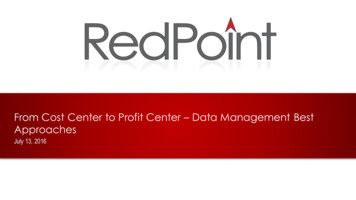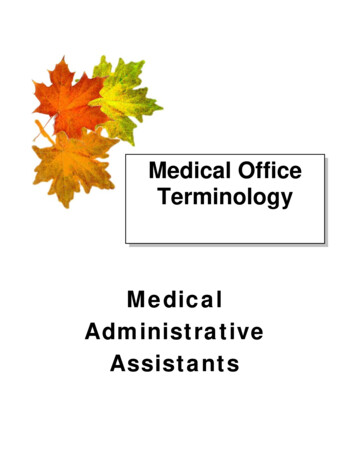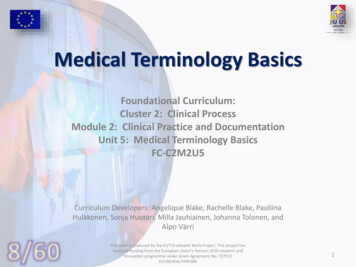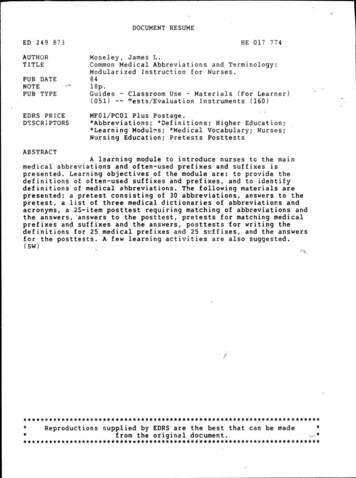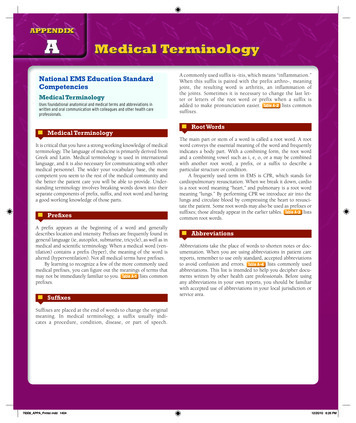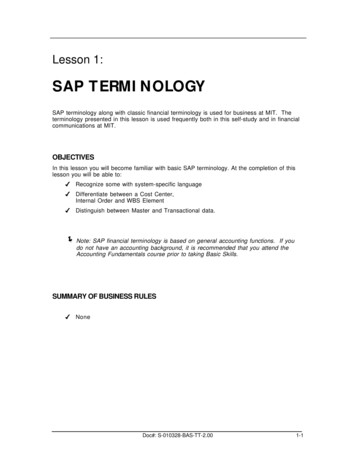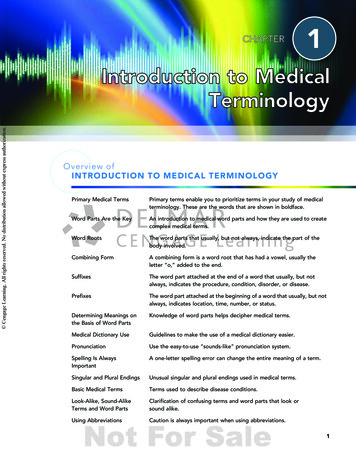
Transcription
D ATA C E N T E RData centerterminology thatwill get you hiredMeredith CourtemancheA photostory
12345678Define the perfect data center jobinterviewBUSINESSES NEED TO knowtheir back-end IT infrastructure is ready to movethe company forward.Modern IT organizationswork closely with an enterprise’s business leaders tocreate, scale up and teardown data center assets ata rapid pace. Flexible andagile IT isn’t just for theWeb-scale data center operators like Facebook andGoogle. Enterprises -- fromsteel companies to coffeepurveyors to insuranceproviders -- are improvingIT operations and realigning data centers for anera when digital enablesbusiness.To land a data center job inthis evolving space, workrelevant, change-focusedterminology into your interviews for engineer, operations or manager positions.Simply rattling off DevOpsand automation terms won’timpress an interviewer,nor will a prevaricating jobcandidate who lacks thefundamentals to grow in adata center position.We’ve created fun visualcues in this slideshow ofhot data center terminologyto help you understandand describe modern datacenter operations. Establish your knowledge of ITinfrastructure scalabilityand resiliency, culture andbusiness trends as wellas other defining developments while leaving astrong impression on yourfuture employer.For more preparationbefore the big interview,check out resources at theend of the slideshow onsample DevOps, sys adminand other data center jobinterview questions.Michael Kloran9
12345678Define change managementas a way to control data centersfrom aboveCHANGE MANAGEMENT GIVESa single administrator control over the actions andperformance of an entirefleet of servers.We define change management as a systematicapproach to support thesometimes unpredictableevolution of IT workloadsand technologies in thedata center. It is aboutautomating workflows, configuration changes, patchesand updates.The definition of changemanagement is increasinglymerging with terms fordata center automation andorchestration. Configuration and change management tools from vendors asdiverse as SolarWinds andIBM give fewer admins control over a greater numberof servers, network nodesand storage devices.When the interviewer askshow you manage yourtime, or how you wouldimprove time managementin the data center, bringup change management.It’s also an integral part ofsuccessful business projectlaunches and expansions.If your data center can’tadapt, your business onlyhas two choices: abandonits growth projects or seekthe back-end infrastructuresupport elsewhere, as in apublic cloud and shadow IT.Michael Kloran9
123456789Define continuous integration anddelivery as Dev meets OpsEVERYONE HAS THE same goalin a good IT organization:Put out the best applications and services on stable,sustainable infrastructure.DevOps helps keep thatgoal on track with continuous integration and delivery.While developers focuson what’s new and next,operations prefers stabilityand consistency.DevOps isa methodology or culture ofIT wherein developers andoperations teams frequentlycommunicate about andcollaborate on applicationand service releases. Manymodern IT shops expectsystems administrators,developers and infrastructure managers to implementcontinuous integration andcontinuous delivery.Continuous integrationmeans that iterative software changes are immediately tested and added tothe larger code base. If achange creates issues, suchas runaway storage use, thatproblem can be isolated androlled back quickly.Continuous delivery takescommitted changes to thecode and shepherds themthrough peer review anduser acceptance testing. Itis an extension of continuous integration. While manyDevOps tools are designedto bring code through bothCI and CD, in practicedevelopers and operationsteams use different tools indifferent ways.Another CD term, continuous deployment, is a goalfor DevOps organizations,though often fraught with real-world complications. Continuous delivery means thatchanges to the applicationor service are ready to bedeployed because they aretested in a production-likeenvironment. Meanwhile,continuous deploymentmeans these changesgo straight to productionwithout awaiting humanintervention.Michael Kloran
1Define data center resiliency aswithstanding destruction2345RESILIENT DATA CENTERSwithstand damage to thenetwork cabling, poweroutages, unexpectedserver downtime, attacks orsurges in user demand andother events by avoidingsingle points of failure andusing adaptable IT systems.In terms of physicalinfrastructure, data centerresiliency increases byinstalling multiples. If onePDU fails, another is at theready to take over its workload. If one carrier goesdown, the business canrun all its workloads over asecond carrier’s connections. N 1 redundancymeans that there’s one extra piece of equipment forhowever many pieces youhave operating. N M couldmean two, three or anynumber of multiples for thatequipment. 2N designatedan infrastructure that’scompleted duplicated forprotection.The definition of data center resiliency has evolvedas IT technologies suchas virtualization and microservices joined traditionaluptime boosters like N 1redundant power suppliesand equipment. Be prepared to discuss distributed applications and serverclusters in a job interview.678Distributed applicationsrun on multiple serverssimultaneously, and maybe architected as independently deployed microservices. Server clustersprevent outages with highavailability or fault tolerantvirtualization, allowing VMsto jump from one server toanother in the event of aproblem.Some data centers todayare designed to fail,meaning that workloadseasily jump off of problemservers and onto new ones,across a server cluster andeven across multiple datacenters. This architectureis moving from the domainof Web-scale content providers into enterprise IT.When you talk about datacenter resiliency to prospective employers, relatethe mechanics -- diversenetwork lines, fault-tolerantclusters -- to IT serviceand business continuity.No matter how beatenup your physical systemsare, or how many outagesare rippling through the ITsystems, the data centercontinues to deliver mission-critical services.Michael Kloran9
1Define parallel processingapplications as a way to outrunbottlenecks2345WHEN YOU WANT somethingdone quickly, double up theresources working on it.Parallel processing, alsodefined as parallel computing, allows multiple serverCPUs or processor coresto execute workflows atthe same time -- in parallel-- by sharing resourcesand coordinating actions.Programs are broken downinto pieces and then recombined, which completesthe work much faster thanserial processing.Parallel processing applications can occur on a singleprocessor with multiplecores, a single server withmultiple processors, oracross clusters or grids ofcomputers. When set upproperly, parallel processing is massively scalable,up to thousands of processors. This is typically seenin supercomputing deployments, not enterprise IT.While serial processingis good for CPUs, serialcommunication is betterfor connections.Peripheralcomponent interconnectexpress (PCIe) is a lowerlatency bus than the parallel PCI, and also has higherdata transfer rates. Serialmeans data can travel over678the bus in both directionssimultaneously, whereas aparallel bus only sends datain one direction at one time.You’ll find PCIe connectionsfor network interface cards,graphics cards and storageaccelerators on data centerservers.Hardware and applications are becoming moreabstracted, with cloudarchitectures and software-defined data centers.However, a fundamentalunderstanding of howdifferent hardware designshandle different workloadswill pay off in the bestuse of available capacityor a simple hardware fixto a bottleneck problem.For example, rather thanrewrite a complex application that is lagging, the datacenter staff can spec localstorage accelerators onPCIe busses. Conversely,when acquiring new hardware for a new application,the data center team canwork with developers andprogrammers to understand how the app will useits resources and plan thebest deployment to serve it.Michael Kloran9
12Define dedupe as a way to organize,free up storage345BUSINESSES RELY ON alibrary of customer data tostay competitive, whetheryour organization sellsinsurance, IT services orsomething else. That librarygets new incoming data,and changes to existingdata, constantly.With multiple applicationsusing this evolving datafrom multiple sources,deduplication becomes anessential tool against storage sprawl. Data centersdefine dedupe as a processto reduce storage demandby saving only one instanceof a data point, rather thanmultiple copies for differentsystems to access separately. Deduplication letsdisparate systems accessthat single data point.An example will help definededupe: Your companykeeps a book of dataabout Customer ABC inits customer relationshipmanagement system’sdatabase. Customer ABCis also part of a pilotprogram for your company’s new product, whichmeans the same book ofdata exists in the development group’s databasefor communicating aboutbugs, new releases and soon. You might also have aseparate database used678for financials that stores allthe same information aboutCustomer ABC. Dedupemeans that the companycan save just one book onCustomer ABC, reducingthe storage room requiredyet not losing any information from which it makesbusiness decisions. Thedata center’s IT systemsmaintain a reference pathso that all three systemsknow where to find thebook on this customer.There are plenty of practical concerns with deduplication. It can be timeconsuming and expensiveto sort through existingdata to match up copies.For new data, storagesystems must include theintelligence to synthesize information into onecohesive book; rather thanwriting a new one eachtime the company startstracking a new parameter.But without dedupe, storage demands and complexity would thwart businessinitiatives like purchasingpattern analytics.Michael Kloran9
12345678Define scalability as the processof growing without changingIT WORKLOADS GROW likesponges taking on water:soaking up resources asthey become available.Data center resource scalability gained importanceas digital technology started to enable every kindof business. Data centercapacity planners definescalability as the back-endIT deployment’s ability togrow proportionally withdemand, without addingcomplexity or difficulty toits management.E-commerce and onlinetransaction processing, aswell as content distributionover the Internet, provethe value of scalability. If aT-shirt maker cannot scaleup its internal customerrelationship managementsoftware and its Web server farm to meet increaseddemand, for example, thebusiness will suffer lostorders and a damagedreputation.Some IT organizations turnto cloud bursting to handleunexpected or unpredictable short-term rapid scaling up. Data center managers plan capacity to suit themaximum typical demandof IT workloads; beyondthat, they rent resourcesfrom a cloud provider asneeded. The T-shirt makerfrom our previous examplemay organically scale updata center servers andstorage as its customerbase grows, then also burstonto Amazon Web Services’ EC2 cloud instancesduring the busy holidayshopping season. Bothmethods fit the definition ofscalability.To prove a depth ofknowledge in capacityplanning, define scalabilityin contrast with elasticity. Elasticity matchesresources to a dynamic ITworkload -- when it needsmore resources, they scaleup; when it needs less, theyscale down. This dynamicreallocation is more difficultto achieve with physicalservers and systems in adata center than with payper-use cloud resources,but with virtualization aswell as cloud bursting, it ispossible.Michael Kloran9
1Define CapEx and OpEx as makingsense of dollars2345RATHER THAN ARGUINGOpEx versus CapEx, it’stime to talk about CapExand OpEx together. Somebusinesses rely more onCapEx IT spending, othersmore on OpEx, but virtuallyall have a mix of both.In the simplest sense, capital expenditures (CapEx)are single payments inexchange for goods orservices, while operationalexpenditures (OpEx) areongoing expenses paid tomaintain a service.Business leaders defineCapEx as one-time purchases that then depreciate in the organization’scare. Data center serversare a classic capital expenditure. Businesses typicallybuy and deploy a fleet ofservers, then depreciatethem over a number ofyears in the data center.We define OpEx as a recurring expense. Cloud-hosted servers are a classicoperating expenditure.The business does notphysically purchase andmaintain the cloud servers,but rather pays a monthlyor per-use fee to accessthem. There is no depreciation; if a server is notneeded, it goes away, andthe company may chooseto pay for it again in thefuture.678With OpEx purchases, it’san oversimplification to saythat you only pay for whatyou use when you use it;any administrator dealingwith VM sprawl wouldagree. And without anasset management system,plenty of CapEx spendinggoes to waste.Show off your understanding of OpEx versus CapExas a matter of close ITalignment with businessneeds. A modern data center employee understandsthat some IT services arebetter handled outsideof the server racks, whileothers will be less expensive in the long term witha big upfront investment inhardware and software resources. One such exampleis big data analytics, wheremany businesses storeand crunch data on ownedIT platforms to avoid thecosts associated withnetwork traffic to cloudbased big data processingservices.Michael Kloran9
12345678Define data center performancemetrics to seal the dealThe point of learningabout DevOps, changemanagement, IT-businessalignment and other hotdata center terminologyis to improve how backend technologies andinfrastructure perform tomeet organizational needsand goals. The proof is indata center performancemetrics.When you’re describingfamiliarity with these concepts at a data center jobinterview,
hot data center terminology to help you understand and describe modern data center operations. Estab-lish your knowledge of IT infrastructure scalability and resiliency, culture and business trends as well as other defining devel-opments while leaving a strong impression on your future employer. For more preparation before the big interview, check out resources at the end of the slideshow on .

